|
Page 353
AMERICA'S AMAZING RAILWAY TRAFFIC
National Geographic Magazine—April, 1923
By WILLIAM JOSEPH SHOWALTER
AUTHOR OF "THE PANAMA CANAL,"
"HOW THE WORLD IS FED,'' "INDUSTRY'S GREATEST ASSET--STEEL,"
"COAL-ALLY or AMERICAN INDUSTRY," ETC., IN THE NATIONAL
GEOGRAPHIC MAGAZINE
IN THEIR role as arteries of commerce, the railroads of the
United States carry the lifeblood of trade to the ends of the
nation.
So great is that task that it is difficult to get an adequate
picture of it; for the statistics of train-miles, car-miles, passenger-miles,
and ton-miles expand into millions and billions so rapidly that
only those who combine the industry of the busy bee and the patience
of the suffering Job can reduce them to terms within the grasp
of laymen.
If all the people of the United States were reviewed in single
file, passing at the rate of one a second, forty months would
elapse from the day the head of the column marched by to the hour
the rear guard approached. Yet the annual transportation task
devolving upon the railroads is equivalent to moving all these
people, with eight tons of freight for each of them, from Paris,
France, to Genoa, Italy.
Stated in another Way, if Father Adam, according to Biblical
chronology, had started a mixed train running down through the
centuries, at a speed of 22 miles per hour, carrying 40 passengers
and 346 tons of freight, and if that train had never stopped from
then to now, it sill would not have covered as great a distance
or performed as large a passenger or freight service as the trains
of the United States do in a normal year.
THE LENGTH OF AMERICA'S RAILWAYS
Counting all sidings, yards, and multiple tracks, there are
approximately 375,000 miles of rails in the United States. How
distant the first mile from the last will the better appear if
it be told that the Twentieth Century Limited—the crack New
York Central flyer between New York and Chicago, maintaining an
average terminal-to-terminal speed of approximately 50 miles per
hour-would require from the birth of the New Year to within a
fortnight of Thanksgiving to cover this mileage.
It is a far cry from the splendid four-track route, with grades reduced to
negligible percentages, and curves all but eliminated, stretching between the
major cities of the country, to the neglected single-track line, with grades
everywhere and curves more numerous than tangents, stretching between Junctionville
and Podunk, the latter characteristic of the railroads of 50 years ago and the
former the latest development of the art of railroading.
Some two decades ago the freight traffic of the country had
grown so heavy that curves and grades regarded as inconsiderable
in the first half century of American railroading became serious
obstructions to the free movement of traffic under 20th century
conditions.
All over the United States one may today see traces of abandoned
rights of way, meandering here and there in a fashion that makes
the traveler think that the car]\engineers must have followed
the cows about and plotted their paths, and remind him that tens
of thousands of miles of railway had to be rebuilt to meet the
nation's demands for better freight and passenger facilities.
MILLIONS FOR MINUTES
With the abandonment of these early railroads have come the
splendid multiple-track highways, without which the present volume
of traffic could not be handled.
A typical case of spending millions to save minutes and pennies
appears in the history of the Lackawanna. That road was first
built half a century ago, primarily as a coal-carrier between
Scranton and New York. Money was not plentiful in those days;
so many a compromise with grades and curves had to be made.
But a day dawned when the Lackawanna saw that if it were to
compete with other companies it must have scores of the grades
and curves on its line ironed out. Across New Jersey from Port
Morris to Delaware Water Gap was a stretch
Page 354—"The
Spirit of Transportation"
355
of road, 39½ miles long, meandering about and dipping
up and down as only old-fashioned roads did.
Nothing less than a cut-off would cure that situation, and
so a line only three miles longer than air-line distance was laid
out, shortening the route between Scranton and New York 11 miles.
Fills and cuts and tunnels required to carry the road diagonally
across deep-valleyed watercourses and high-ridged watersheds made
the cut-off one of the most expensive in the history of railway
building; but it shortened the schedule of passenger trains by
20 minutes, cut down the running time of freight trains by an
hour, and more than doubled the length of the average coal train
moving over the Lackawanna; so that even a million dollars a mile
spent to shorten the line proved one of the best investments that
road ever made.
The same company did another spectacular thing in eliminating
grades and curves when it built its famous viaduct across the
Tunkhannock Valley. That viaduct is nearly half a mile long' and
as high as a 20-story building. The cut-off of which it is a part
saves 3.6 miles between Scranton and Binghamton, but even though
built at a cost of three and a third million dollars per mile,
the Lackawanna made a fine investment in its construction (see
illustration, page 363).
A HIGH-GRADE LOW-GRADE RAILWAY
The Pennsylvania main line between Philadelphia and Pittsburgh
strikes the lay traveler as being about the last word in grade
and curve reduction; and, so far as passenger trains go, it is.
But such a tremendous freight traffic as the Pennsylvania handles
eastward called for even better grades than the main line offers.
The traffic from the Last to the West is so much lighter than
that moving from the West to the East that the engineers can concede
much to westward grades.
So it was decided to build a low-grade freight line from Pittsburgh
to New York. That line now is in operation, except for 23 miles
over the Allegheny Mountains, where the grade is 52.8 feet to
the mile. Its steepest grade in the path of eastbound traffic
is only 17 feet to the mile, up which an engine can pull any train
that it is able to start on the level.
The Pennsylvania has for some time been studying the question
of electrifying this heavy grade over the Allegheny Mountains,
which includes the famous "Horseshoe Curve."
THE LUCIN CUT-OFF
When the Union Pacific was building its line toward the Golden
Gate, the Great Salt Lake lay across its path. In those days it
did what any other railroad would have done—it made a detour.
That detour became a nightmare to the management several decades
later, for it added 44 miles to the journey from Omaha to San
Francisco, made every train lift itself an unnecessary 1,500 feet,
and forced all trains to follow needless curves equivalent to
10 full circles.
So the Lucin Cut-Off across the Great Salt Lake, costing $10,000,000,
was built. It proved a good investment, for the curves, climbs,
and distance eliminated saved some two hours of precious time
and millions of dollars in operating expenses.
The Canadian Pacific, which gets a little look-in oil the United:
States by crossing the State of Maine, has been one of the roads
to modernize its pioneer lines in many places, particularly in
the Rockies and the Selkirks. In the region of Kicking Horse River
in the Rockies there was a heavy grade more than four miles long,
with a rise of 237.6 feet to the mile. It was known as the Big
Hill. Getting a train up that hill was a tremendous task, four
to six engines being required. But getting it down was an even
more arduous undertaking.
Switches were introduced along the line, and those who operated
them had strict instructions to listen for a certain whistle signal.
It meant that the train giving it had gotten out of control and
must be shunted off onto the siding which ran up a grade, thus
effecting a stop.
CANADIAN PACIFIC BUILDS SPIRAL TUNNELS
To overcome these difficulties, the Canadian Pacific decided
to build two spiral tunnels, the first of their kind in America.
The first of these "corkscrew" bores is 3,200 feet
long under Cathedral Mountain. A train entering from the east
turns in
356
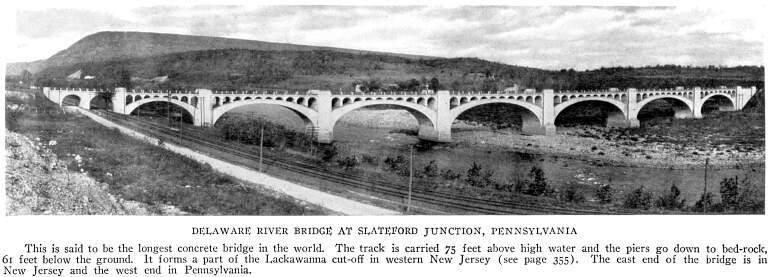
the direction whence it came, and, after emerging, crosses
Kicking Horse River. Then it enters the second spiral tunnel,
and, after descending an elliptical curve, emerges, headed west
again.
The road in this relocation doubles back on itself twice, spirals
its way under two mountains, and crosses the river twice in order
to avoid the Big Hill. The improvement cost $1,500,000, but two
engines do the work of five or six, and a 10-mile speed has become
a 25-mile gait.
The Grand Trunk, in order to command its share in the through
business from Chicago to the Last, had to find a way to eliminate
the river difficulty at Detroit. The St. Clair River connecting
Lakes Huron and Ontario is here about a half-mile wide. Bridging
it was out of the question. Car ferries were too slow. Hence the
railway officials decided to tunnel under the river. They ran
steam engines through, but this soon proved so unsatisfactory
that a substitute had to be found. The B. & O. pioneering
in Baltimore showed the feasibility of electricity, and so the
St. Clair Tunnel was electrified, with such success that under-river
electrified tunnels became a matter of recognized engineering
practice.
Most roads to-day are old ones transformed by extensions and
relocations, but once in a while a new line is built without any
of the limitations imposed by former conditions.
Such a railway is the Virginian, extending from Deepwater,
West Virginia (near Charleston) to Sewalls Point, Virginia (near
Norfolk)—a coal road pure and simple. "I want a road
from the West Virginia coal fields to the sea," said H. H.
Rogers. "It must be a road on which a modern locomotive can
haul 80 fifty-ton carloads of coal from the mines to the seaboard
without breaking up the train. The grades eastbound must not exceed
10 feet to the mile."
It was a large order, but one which the engineer daringly executed,
the
Page 357—The
Lucin Cut-Off Across the Great Salt Lake
Page 358—Five
Modern Means of American Transportation
Page 359—Hell
Gate Bridge, Giving a Through Rail Connection Between New England
and the South
360
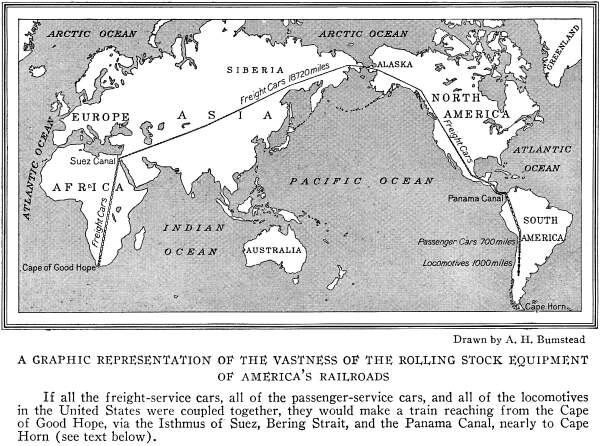
only exception being a stretch of 11 miles, where the eastbound
grade is over a 100 feet to the mile.
But here the largest locomotives in the world act as pushers
and raise the 80-car train intact over the crest of the line.
A whole new coal territory has been tapped, and if the Virginian
Railway hauls 10,000,000 tons of the mined product to market annually
it can operate for 400 years before exhausting its freight supply.
A VAST NUMBER OR ENGINES AND CARS
When one comes to the rolling stock of all the railroads of
the United States, consisting as it does of 2,348,000 freight
cars, 65,000 locomotives, and 53,000 passenger-train cars, and
attempts to visualize its immensity, perhaps the best picture
to be obtained will come from imagining all these engines and
cars coupled into one train.
Suppose this train to be on a sort of vast horseshoe curve,
sweeping through Africa, Asia, North America, and South America
via the Suez Canal, Siberia, Alaska, and Panama (see map above).
So long will the train be that when the last caboose is at
the Cape of Good Hope the forward engine will be only 1,200 miles
out of Cape Horn.
The conductor on the rear platform might listen to the break
of the waves on the South African coast while the brakeman on
the forward freight car gave ear to the ripple of the waves on
the shore of Lake Titicaca, Peru.
The passenger-train cars would add enough length to the train
to make it reach 100 miles beyond Antofagasta, Chile, and the
engines would still further extend the train's length, so that
it would reach nearly to Valdivia, Chile—a train, indeed,
stretching from 30 degrees south latitude in Africa to the Arctic
Circle in Asia, and back to 40 degrees south latitude in South
America!
What a vast series of contrasts among the thousand miles of
locomotives in service on the railroads of the United States!
Here is one that made its appearance in the days of brass bands
around the boiler, red stripes and stars around the smoke-stack
and a name on the cab. Here is the old 999, that once hauled the
Empire State Express on its road to fame, and later took the prosaic
job of hauling light freights on a branch line. Down the
361
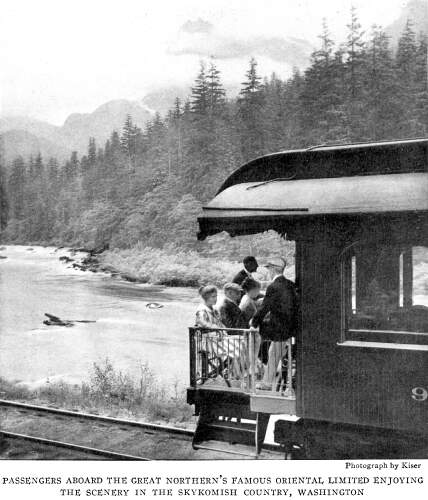 track is a
big Mallet articulated engine weighing 449 tons, having a length
of 105 feet, and possessing cylinders of a diameter equal to that
of the boilers of many locomotives built since the Civil War. track is a
big Mallet articulated engine weighing 449 tons, having a length
of 105 feet, and possessing cylinders of a diameter equal to that
of the boilers of many locomotives built since the Civil War.
A FREIGHT LOCOMOTIVE'S STORY
The work of an average freight locomotive is no light chore.
Its job is to haul a 1,300-ton train 56½ miles each day,
a traffic task equivalent to moving 20 tons from the Statue of
Liberty to the Golden Gate.
Hauling such a train, rain or shine, in warm weather or in
cold, over heavy grades and around sharp curves, takes a heavy
toll out of the freight engine's frame, with the result that for
a full quarter of its time it is on the operating table in the
engine hospital, or waiting its turn to go there.
When the big mogul's performance is measured by the energy
it is able to extract from a pound of coal, it looks like a sheer
waster of fuel, for only about one-twentieth of that energy is
transformed into drawbar pull. But when one remembers that, for
all its limitations, the average
362
freight engine is able to move 10 tons of train a full mile
for each cent's worth of coal burned, its record does not seem
a bad one.
THE ELECTRIC ENGINE'S DEFI
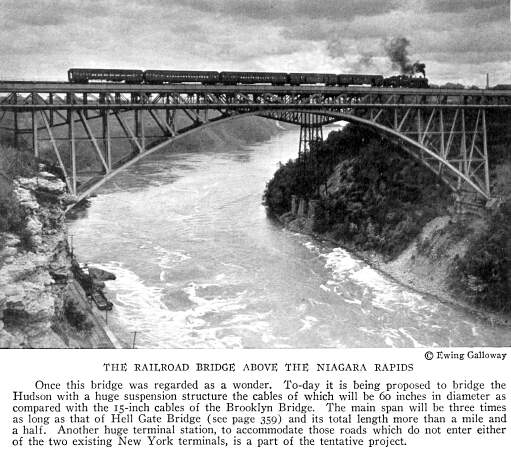 The electric
locomotive, of which there are several hundred in operation in
the United States, could tell a startling story. The electric
locomotive, of which there are several hundred in operation in
the United States, could tell a startling story.
It was born of necessity. When the B. & O. wanted to burrow
under Baltimore, coal-burning locomotives seemed out of the question
for a tunnel so long. So an electric substitute was created. It
showed such good results that one railroad after another tried
electrified tunnels, uniformly with success.
Finally the Pennsylvania and the New York Central decided that
the electric's past performances had been good enough to justify
their building vast terminals in New York City into which no steam
locomotive could be admitted. The electric engine's cleanness
made possible under the river tunnels in the case of the Pennsylvania,
and a two-level track-layout in the case of the New York Central.
Electrifying the terminals led to electrified approaches, and
wherever electricity got a chance to compete with steam, the former
never lost the argument. The electrically propelled train could
show the steam train its green flags at the rear any day, and
its red lights any night. The electric engine was able to get
a 1,000-ton train started from a standstill more quickly than
the steam locomotive, at every trial of their relative power.
In the matter of cleanness and economy of operation, also,
every test showed in electricity's favor. So the Pennsylvania
New York Central, and the New Haven began to electrify their suburban
lines.
Seeing the striking results of electrification around New York,
the Chicago, Milwaukee & St. Paul Railway Co. decided to give
the electric engine a tryout on a long stretch of its transcontinental
363
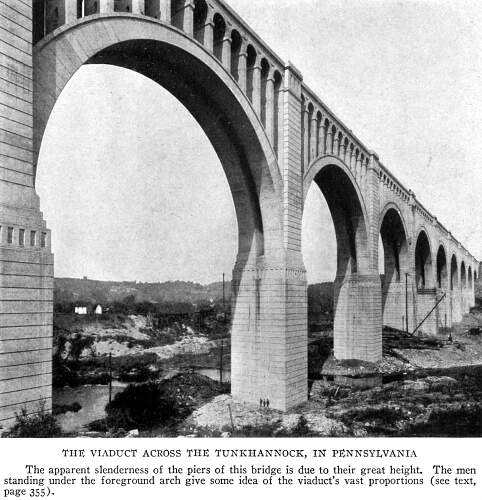 line. It first
electrified a division extending from Harlowton, Montana, to Avery,
Idaho (near St. Maries), a distance of 440 miles. This section
of the C., M. & St. P. crosses the three ridges constituting
the Rocky Mountains, and at one place climbs to 6,300 feet. line. It first
electrified a division extending from Harlowton, Montana, to Avery,
Idaho (near St. Maries), a distance of 440 miles. This section
of the C., M. & St. P. crosses the three ridges constituting
the Rocky Mountains, and at one place climbs to 6,300 feet.
When put to work battling trains over that section, the electric locomotives
began to show their real mettle. Terminal performances, commuter-zone competitions,
and tunnel electrifications are all well enough, but when one comes down to
essentials, a long stretch of road with three mountains to cross, innumerable
grades to negotiate, and all kinds of weather to face—there is the place
to put a locomotive to the real test.
Their performance astonished even electricity's chief supporters.
The railroad company found it could operate its trains much more
efficiently with 42 electrics than with 112 steam-engines. With
the former type it was able to increase the length of each train
by a fifth, thereby reducing the number of trains required. Likewise,
the running time was cut down by a fifth. The electrics, in fact,
demonstrated that they could increase the capacity of a single-track
railroad to a point approaching double-track capacity under steam
operation.
Many a time a train hauled by a "double header" of
steam locomotives rolled up to the electrified division two hours
late, after a bitter struggle with the elements.
364
Radiation from their boilers weakened them, and snow slowed
down their pace.
But the electrics are never happier than when there is zero
weather around, and they made up all the time the steam-engines
lost.
REGENERATIVE BRAKES AT WORK
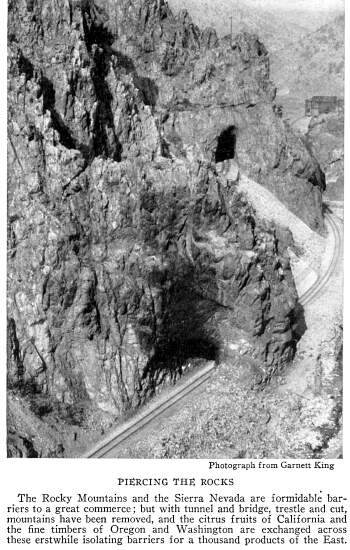 Not only did
the big motors demonstrate their power to pull trains up 2 per
cent grades that would break a steam locomotive's heart, and at
a speed that even three of the latter could not maintain, but
when they got to the top of the mountain they taught a new lesson—superior
efficiency in climbing down again. Not only did
the big motors demonstrate their power to pull trains up 2 per
cent grades that would break a steam locomotive's heart, and at
a speed that even three of the latter could not maintain, but
when they got to the top of the mountain they taught a new lesson—superior
efficiency in climbing down again.
Being equipped with what are known as "regenerative"
brakes, the electric's motor, by the throwing of a switch, is
transformed into a dynamo, and the surplus momentum of the train
rolling down the mountain is expended in driving this dynamo and
sending the electricity thus generated back into the transmission
line.
The problem of getting a steam-drawn train down from the crest
of the Rockies was frequently as serious as that of dragging it
up. The airbrakes frequently were hard to manage, the wheels often
got red hot, the shoes sometimes melted.
But with "regenerative" braking, things have changed.
All the momentum the brakes had to absorb and waste goes back
into the transmission line, to be used as power to pull some other
train up the mountain.
When a steam locomotive has its fires banked in the roundhouse
it burns 200 pounds of coal an hour; when getting up steam it
requires 800 pounds; when standing on side track or at stations
it burns 500 pounds, and when coasting downhill 1,000 pounds.
In none of these situations do electrics require any power
at all. Coasting down the mountain side, they can pay back from
a fourth to a half as much as they borrowed to climb the mountain.
Without a jerk, without noise, without smoke, and without a
cinder, they take
365
their trains up the mountains and down again, at 20 miles an
hour on even so heavy a grade as a rise of 105 feet to the mile,
and at 60 miles on the straightaway level.
THE LONGEST ELECTRIC ROAD IN THE WORLD
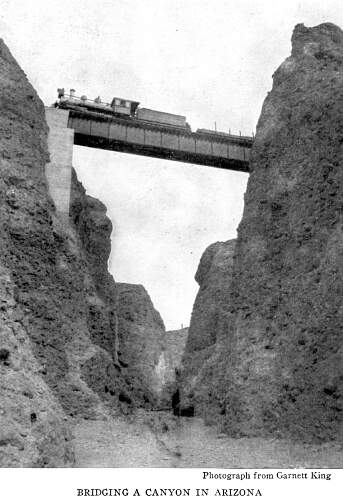 So gratifying
was the electrification of the Harlowton-Avery branch to the Chicago,
Milwaukee & St. Paul authorities that they decided to electrify
the line from Seattle to Othello. This leaves only a 200-mile
stretch to be electrified between the eastern approach to the
Rockies and the Pacific Ocean, and gives the United States the
longest electrified railroad in the world. So gratifying
was the electrification of the Harlowton-Avery branch to the Chicago,
Milwaukee & St. Paul authorities that they decided to electrify
the line from Seattle to Othello. This leaves only a 200-mile
stretch to be electrified between the eastern approach to the
Rockies and the Pacific Ocean, and gives the United States the
longest electrified railroad in the world.
But the test of which the electric locomotive may be proudest
took place not so long ago at Erie, Pennsylvania. One of them,
just out of the shops on the St. Paul's new order, was pitted
against two of the steam giants of the New York Central. They
could not be matched in a tug of war, for, pulling against one
another, a drawbar would be sure to pull out, with perhaps dangerous
results.
So a pushing contest was staged instead. The two big steam
locomotives were coupled together, and thus entered the fray.
On a long stretch of track their engineers were told to open the
throttles wide. With current off, the electric rival was no obstacle
in their path, and they were soon taking it down the track at
a passenger-train pace.
Then something happened; the engineer in the electric slowly
turned on the current. The speed of the big locomotives began
to slacken, and their smokestacks started to spout black smoke
in a way that told how hard they were laboring.
Slower and slower they moved; harder and harder they worked,
as though they were dragging a tremendous train up a heart-breaking
grade; but with all that they could do they continued to lose
speed.
Finally, though their throttles were still wide open and their
cylinders were hissing with the pent-up steam that was unable
to drive the big moguls forward, they were forced to a dead standstill.
Put the pause was only for an instant. Still pushing with the
last ounce of energy within them, their grip on the rails gave
way and they bowed to their master—the electric locomotive.
The latter not only
366
had stalled them, but, turning on them, was driving them back
in full retreat, in spite of the fact that they continued to strain
every rod in their effort to check their onrushing rival (see
page 371).
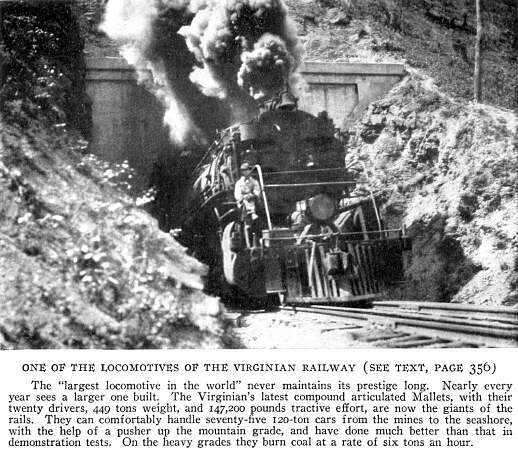 But, even with
that sturdy proof of its supremacy, the electric was not content.
Again it allowed itself to be pushed down the track by its two
big contestants. Again, with wide-open throttles they rushed it
along at high speed. But again a little switch on the electric
engine was thrown, a little switch which converted the motor that
had overpowered its antagonists into a dynamo that acted as a
brake. But, even with
that sturdy proof of its supremacy, the electric was not content.
Again it allowed itself to be pushed down the track by its two
big contestants. Again, with wide-open throttles they rushed it
along at high speed. But again a little switch on the electric
engine was thrown, a little switch which converted the motor that
had overpowered its antagonists into a dynamo that acted as a
brake.
Again the big giants began to labor, to shiver at the load
they were encountering, to slow down under the burden. Slower
and slower they moved, harder and harder they labored, but in
vain! For, whether plunging forward, motor-driven, or holding
back, regenerative-braked, the electric showed itself their master
and proved itself the Samson of rail transportation.
The argument was over, and since that day railroad men everywhere
have realized that the electric locomotive is destined eventually
to succeed the steam locomotive wherever traffic is heavy and
trains frequent.
Already roads are planning in that direction. The Pennsylvania,
the Virginian, and many other lines are reckoning with electrification
of busier divisions as an end to be aimed at.
WHAT UNIVERSAL ELECTRIFICATION WOULD
SAVE
How much the electrification of the railroads of the country
will save is strikingly shown by an investigation based on the
St. Paul's experience and other data. This shows that electricity
can be produced at 2½ pounds of coal per kilowatt hour,
and that 53,000,000 tons would suffice to produce all the electricity
367
required to move the freight of the United States—a saving
of more than 100,000,000 tons a year.
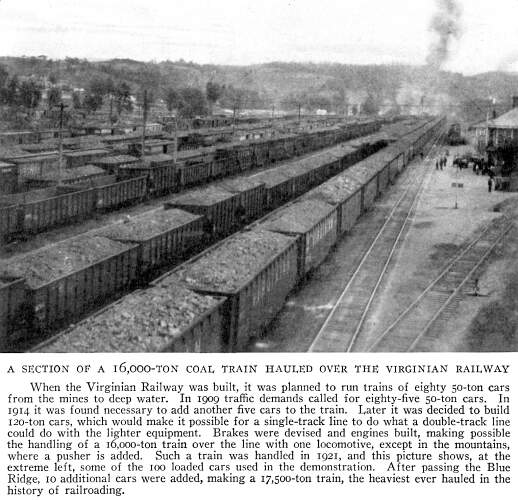 These figures
do not deduct anything for the added saving made possible by the
use of hydroelectric power-the white coal of the country's unharnessed
rivers. They are based on all power being produced by coal-driven
dynamos These figures
do not deduct anything for the added saving made possible by the
use of hydroelectric power-the white coal of the country's unharnessed
rivers. They are based on all power being produced by coal-driven
dynamos
Think of five big carloads of coal being wasted every single
minute of the year; of five Niagaras running unharnessed to the
sea! There you have a measure of what the electric locomotive
promises to save, once it supplants the steam locomotive as the
source of rail transportation's power.
With all their lines electrified there would be no reason for
the railroads hauling a ton of coal for themselves. There are
hundreds of power sites that could be developed, which would greatly
reduce the coal tonnage required to drive the dynamos necessary
to generate sufficient current to move all the trains of the country.
The power remaining to be supplied by coal could be generated
at the mouth of the mine and sent out over wires.
To be relieved of the transportation of approximately 150,000,000 tons of coal
a year would mean the saving of more than 3,000,000 carloads of freight, or
60,000 trainloads of 50 cars each. In other words, the coal trains required
to haul the fuel used by the railroads themselves to-day would fill eight tracks
reaching from Sandy Hook to Golden Gate, and all of this tremendous train movement
would be saved by electrification of all lines.
The saving effected if electrification
Page 368—Climbing
the Rocky Mountains
Page 369—The
Prosperity Special at Stein's Pass, New Mexico
370
were adopted only on the Atlantic seaboard from Boston to Washington
is strikingly shown in a report prepared, at the instance of former
Secretary of the Interior, Franklin K. Lane, by the United States
Geological Survey, under the direction of Dr. George Otis Smith.
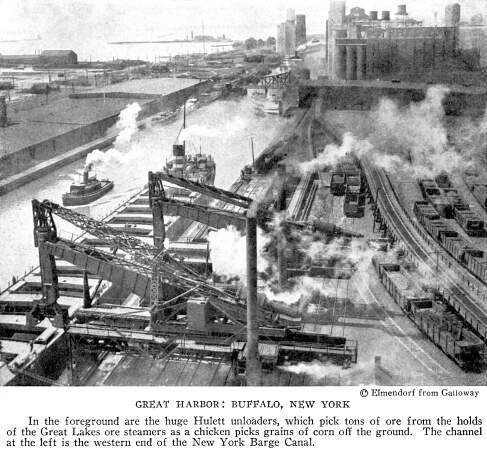 This report,
entitled "A Superpower System for the Region between Boston
and Washington," shows that in 1930 the territory in question,
for its municipal, industrial, private, and railroad purposes,
will require 31 billion kilowatt hours of power, which could be
furnished under a coordinated power system at a saving of $239,000,000
per annum. This report,
entitled "A Superpower System for the Region between Boston
and Washington," shows that in 1930 the territory in question,
for its municipal, industrial, private, and railroad purposes,
will require 31 billion kilowatt hours of power, which could be
furnished under a coordinated power system at a saving of $239,000,000
per annum.
In the case of the railroads, 19,000 out of 36,000 miles of
track could be profitably electrified, at an annual saving in
operating costs of $81,000,000 on a capital investment of $570,000,000.
To-day the average steam locomotive works eight hours a day,
while the average electric is ready for twenty hours a day service.
It is estimated that there will be a doubling of traffic in
this zone by 1930, and that the cost of electrification would
be less than the cost of added facilities necessary in adhering
to steam power.
One of the secrets of the electric engine's efficiency as compared
with the steam locomotive is the greater adhesion of its drivers
to the rails. Indeed, it can run twice as fast at maximum adhesion
as the steam locomotive.
Some roads are beginning to use motor buses with marked success
for the transportation of passengers on lines where the traffic
is light. The Pennsylvania's western lines, feeling the pinch
of competition from interurban electric lines and highway bus
lines, are turning to motorized train service in order to reduce
the
371
cost of operation to a point in keeping with the revenues derived.
THE FREIGHT CAR'S SHARE IN THE WORLD'S
WORK
 When one sees
a string of freight cars, some of them for carrying live stock,
others for moving products needing refrigeration or ventilation,
still others for hauling such diverse products as coal and oil,
bulk molasses and ore, it is probably With little realization
of the stories they might tell. When one sees
a string of freight cars, some of them for carrying live stock,
others for moving products needing refrigeration or ventilation,
still others for hauling such diverse products as coal and oil,
bulk molasses and ore, it is probably With little realization
of the stories they might tell.
If their several stories were made into one composite tale,
we would learn that the average car in a recent year ran about
22 miles a day, carried 27.8 tons of freight per load, and secured
about 17 loads during the year. One-third of the 9,200 miles it
traveled was as an empty.
One does not have to study transportation problems long to
find out what a valued public servant the little-appreciated and
unpretentious freight car actually is. There is one of them for
every eight families in the country, and to them agricultural
and industrial America owes a tremendous debt.
What would bonanza crops be worth if there were no freight
cars to carry them to the markets of the nation and to start them
to the hungry mouths of the world?
How could great factories thrive without the raw materials
and the fuel the freight car brings to them, or without the many
markets to which it gives them access?
"You never miss the water till the well runs dry"
might be paraphrased into "You never appreciate the freight
car till there's a car shortage." Indeed, the freight cars
are the red corpuscles of the body politic, through which the
oxygen of industry and the nutriment of commerce reach the cells
that constitute our national life.
In order to obviate the building of large numbers of new freight
cars, a national campaign has been started to increase their average
daily mileage, to add to their average load, and to cut down the
number of days they are out of service awaiting and undergoing
repairs.
The railroad executives responsible for the campaign want to
speed up the cars, so that they will average 30 miles a day
Page 372—An
Electrified Road in the Cascades
Page 373—The
De Witt Clinton Runs Once More
Page 374—When
a Locomotive Goes to the Hospital
Page 375—Loading
a Passenger Car at Seattle for Shipment to Alaska
376
instead of the 23 they have been making. They want to increase
the average load by 2.2 tons, and to cut down the average daily
number on the "sick list" from 7 per cent to 4 per cent.
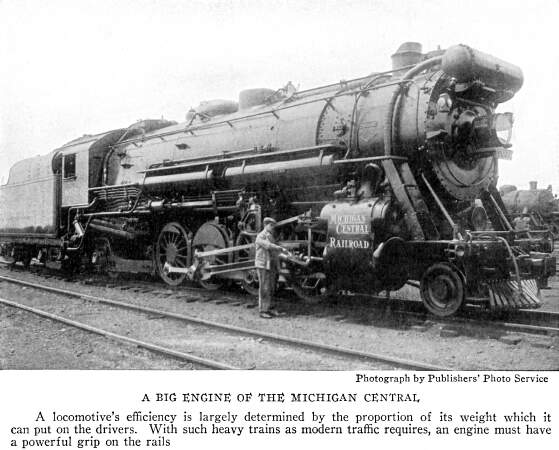 This would appear
to the layman a very easy task. Yet the railroad man realizes
that it is vastly more difficult than it seems. The fact is that
thirteen-fourteenths of a car's year is spent off of the main
tracks, either being switched around some yard, being loaded or
unloaded, undergoing repairs, or just standing idly by waiting
for something to turn up. This would appear
to the layman a very easy task. Yet the railroad man realizes
that it is vastly more difficult than it seems. The fact is that
thirteen-fourteenths of a car's year is spent off of the main
tracks, either being switched around some yard, being loaded or
unloaded, undergoing repairs, or just standing idly by waiting
for something to turn up.
HOW A FREIGHT CAR SPENDS ITS TIME
Of its year the average car spends fourteen weeks on loading
and unloading tracks; six weeks being switched into and out of
trains and onto and off of loading tracks; two weeks awaiting
shippers' orders; five weeks working its way through the maze
of division yards; nine weeks in delivery from one road to another.
Then there are three weeks more lost by its arrival at its
destination on Sundays and holidays, and five more while going
through the repair shops. Slack seasons cause it another two weeks
of idleness.
These items show forty-six weeks out of the year spent off
of the road. Of the remaining forty-three days, which represent
its gross time on the road, eleven may be counted off for time
spent running empty in search of a load, and five more may be
deducted for delays incident to washouts, congestion, and the
like.
All of which so taxes the car's time that it is able to spend
only 27 days of actual running under load, and all of which tends
to make an average Of 30 miles per day a hard one to attain.
Thirty tons per car, the second aim of the railroads to-day,
is almost as difficult of realization as 30 miles per day. Even
under the severest stress of the war period, when every shipper
made it a point of patriotism to get his cars loaded to capacity,
it wasn't possible to reach that standard of loading efficiency.
377
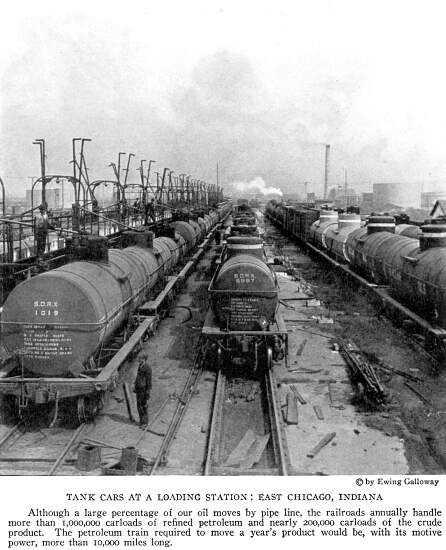 In the first
place, a stock car carries less than 10 tons of hogs, less than
11 of sheep and goats, and less than 12 of horses and mules. Likewise,
box cars load less than 13 tons of hay and straw, cotton, wool,
and eggs. On the other hand, coal cars force the average loading
upward. During the second quarter of 1920 they moved more than
50 tons of bituminous coal, nearly 48 tons of anthracite, and
more than 51 tons of iron ore. In the first
place, a stock car carries less than 10 tons of hogs, less than
11 of sheep and goats, and less than 12 of horses and mules. Likewise,
box cars load less than 13 tons of hay and straw, cotton, wool,
and eggs. On the other hand, coal cars force the average loading
upward. During the second quarter of 1920 they moved more than
50 tons of bituminous coal, nearly 48 tons of anthracite, and
more than 51 tons of iron ore.
The third aim of the railway managers is to shorten the time
lost by the cars forced out of service by bad condition. It is
estimated that by a little careful scheming the average car's
"sick leave" can be cut down to 14 days a year.
If the slogan of "30 miles per day, 30 tons per load,
and 14 days for 'sick leave'" could be transformed into an
achievement, the railroads would have additional service out of
its cars already in commission equal to that which could be rendered
by 260,000 new ones. An
378
additional mile per day would equal the mileage of 100,000
new ones; an additional ton per day would give as much service
as 80,000 new cars could render, and the reduction of "sick
leave" to 14 days would yield the same results as the addition
of 80,000 new cars.

"TRAMP STEAMERS" OF THE RAILS
Freight cars have a way of wandering from their own lines and
becoming the rail counterparts of tramp steamers. When the demand
for cars is acute it is very much cheaper for a railroad to keep
a "foreign" car than to return it to its home line;
for the "per diem" charge for a foreign car is only
one dollar a day.
Not long after the outbreak of the World War a St. Louis car-builder
had an order for some freight cars from a California road. He
started one west loaded, to save haulage charges. It delivered
its load and then began to wander around. It made two or three
trips to the Atlantic seaboard, a half dozen up and down the country,
and finally, long after the armistice, reached its destination.
There are instances of cars wandering around the country for seven
years before setting wheels on home rails once more.
The freight car is the Cinderella of the transportation household.
The passenger car flits about at high speed, day after day, and
never would be able to support itself except for the toiling of
its humble sister. If the passenger trains had to pay their half
of all the expenses of railroad operation-for they make half the
train mileage-they world show one of those dreaded red-ink balances
in the profit-and-loss account.
The average passenger car runs far enough to make two trips
around the earth every year, and some of them run for a full generation-first,
usually, in the big express trains, then on the mainline locals,
and finally out on some "Jerkwater" branch or in the
dollar-excursion equipment.
HAULING THE NATION'S FREIGHT
Turning from tracks and rolling stock to freight, one finds
an equally startling story of the amazing proportions of railroad
transportation.
Page 379—A
Freight Yard in the Anthracite Region: Carbondale, Pennsylvania
380
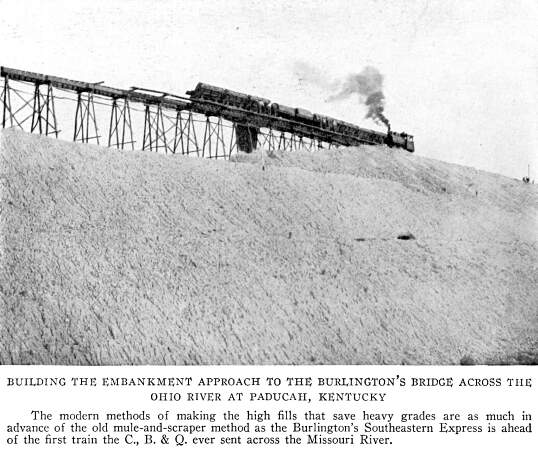 The national
balance sheet of work accomplished in 1919, which year is taken
as the most nearly normal of any since the armistice, showed that
1,096,000,000 tons of freight were loaded into cars, and that
the average ton was hauled 301 miles. The national
balance sheet of work accomplished in 1919, which year is taken
as the most nearly normal of any since the armistice, showed that
1,096,000,000 tons of freight were loaded into cars, and that
the average ton was hauled 301 miles.
That represents the loading of a pile of merchandise as big
as the great Pyramid of Cheops and hauling it from Washington,
D. C., to New Haven, Connecticut, every eighteen hours,
If we could load the tremendous store of freight that moves
in a year's time into one string of cars, it would be 312,000
miles long.
Imagine, if you can, a huge transcontinental railroad yard,
stretching from New York to Seattle, via the meanderings of the
Pennsylvania and the St. Paul, through Pittsburgh, Chicago, Milwaukee,
St. Paul, Butte, and Spokane; and then imagine one hundred tracks
in this vast continent-spanning yard packed solid with cars—box
cars, coal cars, tank cars, refrigerator cars, stock cars, and
flat cars—each and every one of them filled with the products
of a nation's industry! That will give you a picture of the vastness
of the interchange of commodities between the communities of a
busy nation.
Forty of these tracks would be filled with the products of
the nation's mines, 29 with the merchandise of its factories,
18 with the commodities that come from its farms, and 11 with
forest products.
ITEMS OF OUR ANNUAL WAY BILL
If one wishes an itemization of some of the individual commodities
included in those major groups, it may best be given in terms
of trains standing in this imaginary transcontinental yard, with
cabooses resting on the banks of the Hudson.
The butter and cheese moving by freight (there are no statistics
of commodities moving by express) would fill a train reaching
almost to Huntingdon, Pennsylvania.
The American hen gives the railroads more traffic as a producer
of eggs than the American cow contributes through her output of
butter and cheese, for the
381
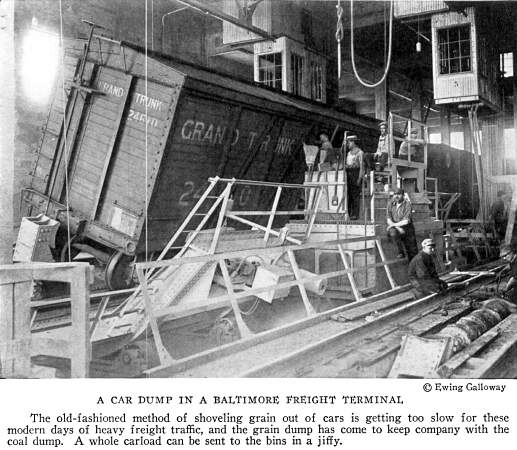 egg train would
exceed by more than a hundred miles the length of the one carrying
butter and cheese, and would reach considerably beyond Johnstown.
There are no comprehensive statistics which would enable one to
estimate the length of the annual milk and cream train, as these
products are hauled largely by express. egg train would
exceed by more than a hundred miles the length of the one carrying
butter and cheese, and would reach considerably beyond Johnstown.
There are no comprehensive statistics which would enable one to
estimate the length of the annual milk and cream train, as these
products are hauled largely by express.
Our love of "something to drink" brings to the railroads
more traffic than our demands for something to wear, the textiles
requiring some three thousand fewer cars than beverages, which
would load a train reaching from Hoboken, New Jersey, to Alliance,
Ohio.
The annual freight traffic in horses and mules, despite the
competition of the automobile, sends some 80,000 carloads over
the rails—enough to make up a train reaching to a point considerably
beyond Bucyrus, Ohio—while the train required to represent
our citrus-fruit movement would stretch from Hoboken, New Jersey,
to Lima, Ohio.
American devotion to "my lady Nicotine" contributes
considerably to the traffic task of the railroads. In a recent
year more than 90,000 carloads of tobacco and tobacco products
moved by freight, and the train required to move it would be some
750 miles long-extending all the way to Fort Wayne, Indiana.
That we are considerably addicted to the use of canned foods
is shown by the fact that those moving by freight in a recent
year would fill a train reaching from the banks of the Hudson
almost to the banks of the Wisconsin.
The American sweet tooth, likewise, is well catered to by the
railroads. Sugar, syrup, glucose, and molasses moving by freight
during a single year yield nearly 200,000 carloads of traffic—enough
to make up a train whose headlight would illuminate the banks
of the Missouri River at Mobridge, South Dakota, while its caboose
was still in the Jersey City yards.
Even at that, the humble potato can go
Page 382—An
Airplane View of the Clearing East Classification Yard, Near Chicago
Page 383—A
"Container Car" Operating Between New York and Chicago
Page 384—Railroad
Yards at Cleveland, Ohio
Page 385—An
Aerial View of the 72d Street Freight Yards, New York
Page 386—A
Rotary Snow Plow in Operation
Page 387—Ice-Covered
Locomotives Just in from a Wintry Run
Page 388—Jersy
City Terminal Equipped with Electro-Magnetic Interlocking Signal
Service
389
our sweet goods one better, requiring nearly 25,000 more cars.
Our annual potato train is more than 1,800 miles long and would
reach to a point within 100 miles of the Montana border.
The American hen, in addition to her egg contribution to the
freight traffic of the country, makes a second large contribution;
the train required to move the poultry she offers would fill a
track reaching from the banks of the Hudson to the foothills of
the Rockies.
The ice moving by rail as freight is a very small percentage
of that used by the American people, and yet the cars required
for its movement would fill a track reaching well into the valley
of the Yellowstone, while the cotton train's forward engine would
be farther west than the western boundary of Yellowstone National
Park. The products of the American packing towns would fill a
train reaching from New York to Spokane.
The automobiles and trucks moving by freight would fill one
solid transcontinental train and a second one reaching to Pittsburgh,
while the wheat so moving would fill one transcontinental track
and another one reaching half way across the continent.
Iron ore would demand 4,300 miles of cars, while coal and coke
would require a train 40,000 miles long.
The variety of the requirements of the American people is no
less remarkable than the volume of those requirements. On the
list of commodities hauled by the railroads there are more than
8,000 different items, which embrace every kind of product, from
abas, worn by Arabs as garments, to zymoscopes, used by zymologists
as ferment-testers.
WHERE THE GEOGRAPHIC COMES FROM
Under the blessings of adequate transportation the interchange
of products is amazing. For instance, take so simple a thing as
your copy of the NATIONAL GEOGRAPHIC MAGAZINE.
The paper is made in Massachusetts, from pulpwood grown in
Canada, treated with acids coming from half a dozen States, and
coated with clays coming from England and Florida.
It is printed with presses made of steel wrought in Pennsylvania,
from pig iron extracted in Ohio, with the aid of limestone from
Michigan and coal from West Virginia, from ore mined in Minnesota.
The glue for the rollers of the presses comes from the trimmings
of skins brought from India, China, and South America, including
goatskins, beef hides, and horse hides. The glue for pasting on
the cover comes from Pennsylvania, where it is manufactured from
raw materials coming from as widely separated points as Cape Town,
South Africa, Aden, Arabia, and Buenos Aires, Argentina.
The ink is a lesson in geography all by itself. It is made
of carbon gas black from Louisiana; linseed oil from Minnesota,
Argentina, and India; mineral oils from many American oil fields;
vegetable oils other than linseed, from the cotton belt and China;
dryers from Brazil and Canada; dyes from various States; and gums
from New Zealand, the Dutch East Indies, and the South.
The type metal is made of lead from Missouri, copper from Montana,
tin from the Straits Settlement, and antimony from Japan.
WHY MOST OF OUR FREIGHT MOVES EASTWARD
Handling freight trains is an interesting task from the layman's
standpoint, a hard one from the trainman's point of view, and
an involved one from the yard-master's aspect of the work.
With a tremendous export balance and such a large percentage
of the country's population massed along the eastern seaboard,
it is inevitable that much more freight has to move eastward than
is dispatched westward. How to keep the car supply adjusted without
unnecessary westward movement of empties is one problem, and how
to prevent empties from moving eastward after they have discharged
westbound loads is another.
In a recent year the freight trains of the country ran, in
round numbers, 51,000,000 hours. Each train ran about 72 miles
a day at 10.5 miles an hour, including stops and waits.
The making up and breaking up of the vast number of trains
that move each 24 hours are constantly being accelerated through
the installation of improved freight yards.
Page 390—The
Union Station and its Environs, Washington, D.C.
391
Formerly, all tracks in these yards were level, and a train
was broken up or made up, as the case might be, only by innumerable
switchings back and forth. In the new "hump" yards much
of this is done away with. A train comes in off the line. It is
backed up to the top of a steep grade. Here, mayhap, a score of
tracks spread out from the one on which the train stands, each
connected with it by a series of switches, or a "ladder,"
as these switch series are known in railway parlance.
Then one by one or group by group the cars in the train are
uncoupled and allowed to roll by gravity down the ladder and onto
the several tracks on which all cars of common destinations beyond
are being gathered. These tracks are known as classification tracks.
To one go the cars bound through to Chicago; to another those
with St. Louis as their destination; to still another those having
transcontinental destinations. And so it goes (see illustration,
page 382).
GETTING FREIGHT OVER THE ROAD IS NOT
CHILD'S PLAY
Whether the cars being sent by gravity down the incline and
onto their respective tracks are from a train that has just rolled
in or from scores of sources, each goes to its particular track,
and one switching crew with one engine does the work that six
crews and engines do in the old-fashioned yards.
And it is well that things can be speeded up, for in 20 years
the freight business of the American railways has increased threefold
and is still expanding.
In one yard not long ago 121 eastbound trains, with more than
3,200 cars, and 78 westbound, with 3,600 cars, arrived in 24 hours—a
train every 7½ minutes; and of course these had to be broken
up and made over into about as many other trains.
To the train crew the caboose is a "hack," and most
crews have their "pet hacks." When the end of the division
is reached they usually get a load back, but if there is nothing
in sight the engine runs "light" back to the other end,
sometimes taking the caboose along.
Getting freight over the road is hard work at best. Ask the
firemen who have to fire the engines through the Baltimore tunnels
of the Pennsylvania how often one of their number shows up unconscious
after a trip through these gas-filled bores. Ask the brakeman
who has to toil through the night with rain and cold as companions
as he walks the long platform atop his train.
But at worst, think of 40 transcontinental trains snow-bound
and idle in the single State of Wyoming! Think of 25 feet of snow
on the level and 50 in canyons and gulches! Think of thermometers
in which the mercury tries to hide itself from the frost, in weather
where zero temperature would seem moderate by contrast!
Yet through it all the engineer must have an unobstructed vision;
the fireman must shovel an unwonted quantity of coal into the
firebox; the brakeman must protect his train, operate his switches,
and always be ready if the air-brakes should fail to work. Water
tanks become masses of ice without and freezing water within.
On one line 40 miles of telegraph poles were broken down by
a snow and sleet storm, most of them falling across the tracks.
On another every bridge and trestle for miles was carried down
stream by an unrelenting downpour.
Snow time is worst of all. When the weather forecaster sees
a big snow storm in the offing he acts as intelligence officer
for the railroads, and they begin to marshal their forces for
the fray. Every engine in every roundhouse must have steam up,
ready at an instant's notice to take the road and help to keep
the rails clear. An ounce of prevention was never worth a fuller
pound of cure than in fighting the snow. The division superintendent
becomes a general, and mobilizes the last ounce of his reserves
in motive power and men.
Trains are shortened, and the intervals between them cut down.
If the flakes come too fast for such strategy in keeping the line
open, the engines are equipped with ordinary plows, which buck
the drifts and push them to one side.
But if the hordes of the snowflake armies become so numerous
as to overwhelm even these, the big rotary plows are sent into
the fray. These possess great cutting wheels able to drill a bore
whose diameter will permit the passing of a train.
392
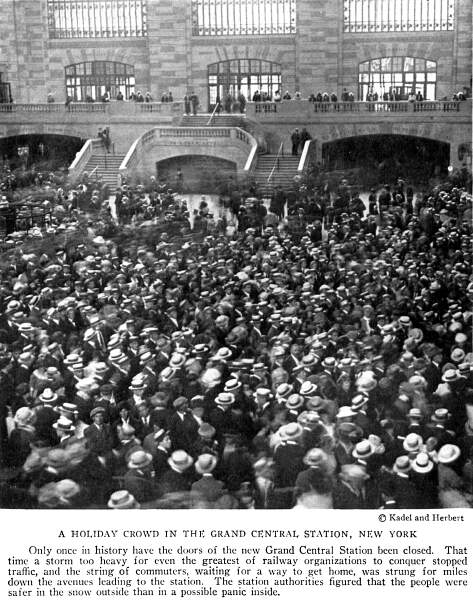 Shoved forward
by perhaps three engines, a rotary plow eats its way into a big
drift, discharging the snow through a giant nozzle that extends
out over the right of way, and throwing a stream of flakes that
would engulf an ordinary building in short order. Therefore it
is built so that the nozzle-man can regulate the direction of
his stream and thus avoid such catastrophes. Shoved forward
by perhaps three engines, a rotary plow eats its way into a big
drift, discharging the snow through a giant nozzle that extends
out over the right of way, and throwing a stream of flakes that
would engulf an ordinary building in short order. Therefore it
is built so that the nozzle-man can regulate the direction of
his stream and thus avoid such catastrophes.
In the terminals and freight yards a snowstorm means frozen
frogs and out-of-commission switches. Brooms, oxyacetyline blow-pipes,
and such have to be called into service, and a stiff battle must
be waged if trains are to be kept moving.
Latterly, experiments have been made in the direction of installing
electric heaters at switches, and one of the foremost terminal
superintendents in the country tells me that lie believes the
day is not
393
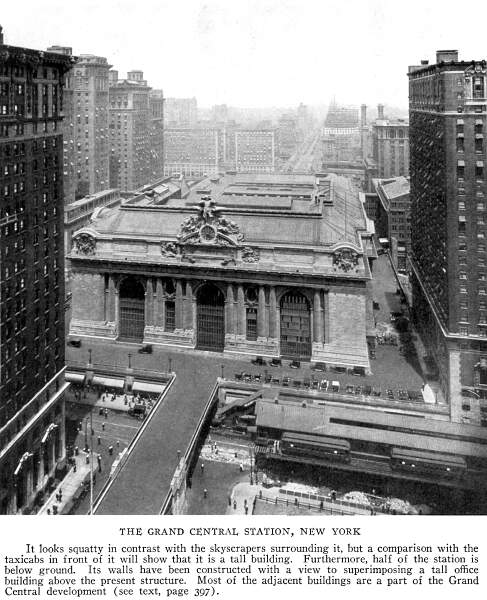 distant when
snow will be deprived of its terrors, so far as terminals are
concerned. distant when
snow will be deprived of its terrors, so far as terminals are
concerned.
A VAST ARMY OF TRAVELERS
The story of the passenger traffic of the United States is
one of a volume of business no less astonishing in proportions
than the freight traffic.
Imagine the vast array of folk who ride over the rails of the
country in a year transformed into an army of marching troops,
in solid formation and 257 abreast. The rear guard of that vast
army would be waving their farewell to the skyline of New York
as the advance guard was hailing the Golden Gate at San Francisco,
if the line of march were an air line. Truly, 1,175,000,000 passengers
is an imposing multitude of people!
And the aggregate miles they traveled! In its annual marathon
around the sun, the earth is about the speediest thing we
Page 394—A
Berth in a Regulation Pullman
395
know. It hurtles through space at so great a gait that it covers
a distance equal to that which stretches between Ottawa, Canada,
and Tallahassee, Florida, in a single minute. And yet, even with
such a speed record, it cannot pile up mileage as fast as the
American people in their railroad travel.
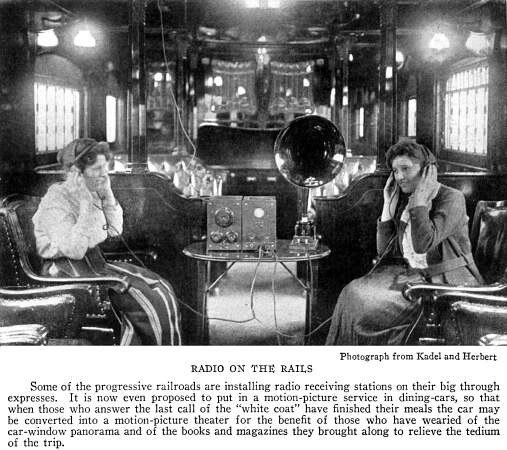 Indeed, if
the earth were to speed up its gait eighty-fold its annual mileage
would be no more than equal to the 46 billion miles covered by
the travelers of the United States in a normal year. Indeed, if
the earth were to speed up its gait eighty-fold its annual mileage
would be no more than equal to the 46 billion miles covered by
the travelers of the United States in a normal year.
There are many things about passenger traffic that constitute
wonder stories of the transportation industry, concerning which
lack of space forbids even a mention. The tales of the time-table,
the baggage business, the ticket-sellers, the sleeping-car service,
to say nothing of scores of other activities, must go untold.
But there is one phase of passenger travel that arrests the
attention of everybody—that of the modern passenger station
in a major city.
To visit one of these big terminals and there to study the
art of handling vast throngs of humanity and amazing numbers of
trains, to go down into the dispatcher's office, out to the information
bureau, and through the whole plant, indeed is an experience not
to be forgotten.
South Station, in Boston, with its 45,000,000 passengers and
196,000 trains a year, holds the American record for volume of
traffic. North Station, in the same City, with its 32,000,000
passengers annually and 400 trains daily, holds the record for
a station serving only one road. Union Station, in St. Louis,
with 22 roads entering it, holds the record for the number of
lines served.
But in their modernity, in the intricacy of the problems solved,
in their construction and operation, in the probable future expansion
of their patronage, no other
396
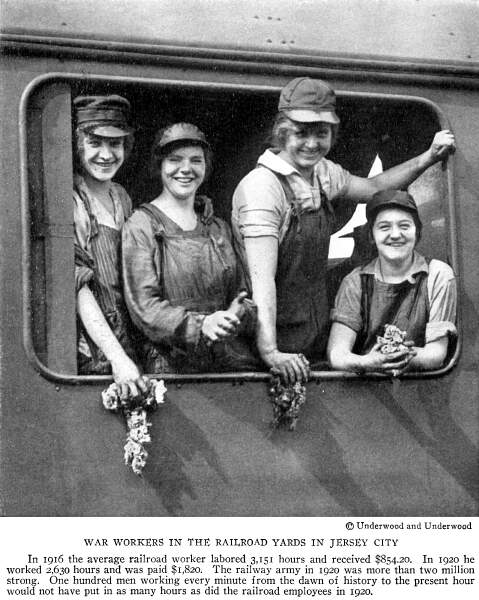 stations in
the world claim as much interest from the public generally as
the Pennsylvania and Grand Central stations, in New York. stations in
the world claim as much interest from the public generally as
the Pennsylvania and Grand Central stations, in New York.
The Pennsylvania is the largest terminal under one roof in
the world; but the Grand Central, with its two levels, covers
double the acreage of the Pennsylvania. The latter was built as
a railroad station pure and simple, while the former was constructed
as a real-estate development, which should provide every possible
convenience known in the art of transportation, and to surround
the station with associated interests, such as hotels and office
buildings.
The New York Tunnel Extension of the Pennsylvania, with the
station and its appurtenances, cost about $115,000,000 while the
Grand Central cost $75,000,000. By the broad idea of making a
business center on the land redeemed by electrification
397
 and that which
had to be condemned to provide for the underground trackage, the
Grand Central Station, with its group of surrounding edifices,
has been made a self-supporting institution. and that which
had to be condemned to provide for the underground trackage, the
Grand Central Station, with its group of surrounding edifices,
has been made a self-supporting institution.
THE STORY OF GRAND CENTRAL STATION
A trip through the Grand Central Station is a revelation. Every
day 600 trains arrive and depart; 33,000,000 passengers pass its
portals in a single year. Its public rooms have an area of six
acres and its main concourse could accommodate 15 regiments of
infantry. Its facilities are so arranged that no passenger need
retrace a step-ticket window, Pullman office, checking-room, all
coming in their order on the traveler's way to his train.
While, of course, the primary purpose of the New York Central
was to build a great station, with an ultimate capacity of upward
of 75,000,000 passengers a year, yet electrification made it possible
to reclaim 40 acres of land in the very heart of upper Manhattan—all
over the two levels of the 32 miles of terminal tracks—and
to utilize this area for the biggest single civic development
in the history of architecture,
The main station building, whose suburban and express levels
are connected by long inclines, or ramps, instead of by stairs,
has a veritable labyrinth of inside streets and passages lined
with shops and stores. One can, without going out of doors, reach
three subways, three hotels with 3,000 rooms a series of office
buildings housing 6,000 workers, and two big university clubs.
Great as has been the development of the reclaimed areas by
the construction of 'office buildings, hotels, clubs, stores,
and apartment houses over the station and approach tracks, vast
additional structures are expected to rise, Even the main concourse
itself was built with a view of ultimately surmounting it with
a 17-story office building.
One of the remarkable things about the construction of the
Grand Central is that it was built as a substitution. The whole
structure and its satellite buildings had to go up, their predecessors
had to be torn down, and the substitution of electricity in the
place of steam had to be wrought
Page 398—Results
of a Rear-End Collision at Sulpur Springs, Missouri
399
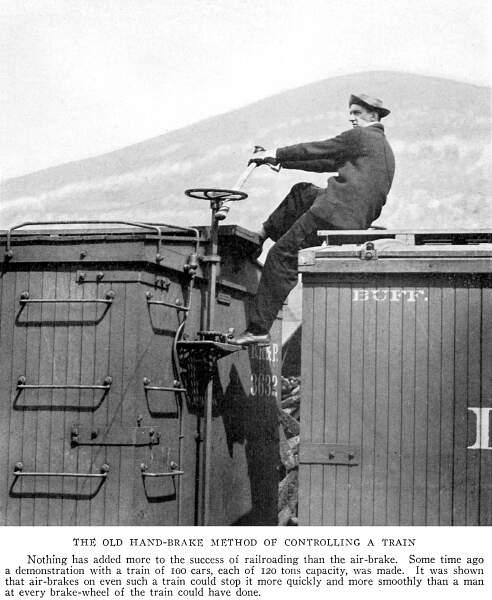 while passengers
were coming and going and trains arriving and departing. while passengers
were coming and going and trains arriving and departing.
Vast yardages of stone and dirt were blasted and moved, amazing
tonnages of structural steel and hollow tile and brick were removed
here and put into buildings there, but traffic went on as though
nothing could happen.
There are hundreds of superlatives about the Grand Central
Station to which space does not permit even a passing reference.
But surpassing everything else is its work of handling 600
trains that come in and go out every day. To get a faithful picture
of that task, one must take a few notes to begin with.
The two-story railroad—for that is what it amounts to—in
the terminal is entirely below the street level. The second story
tracks are 34 feet below the street level and the lower story
tracks 55 feet.
On the upper level there are 41 tracks
Page 400—A
Modern Interlocking Signal Tower
The Men Who Control a Modern Classification Yard
401
and on the lower 22. In addition to these, there are 62 other
tracks on the two levels used for storing engines and cars, with
a big loop on the lower level, built so as to permit trains to
be turned around without shifting or backing out of the station.
Under the old way of railroading, men had to set switches and
signals by hand, out on the track itself. Then came the tower,
with its levers enabling a man to set them at a distance, but
still by hand.
But manifestly, with 238 different sets of points and crossings,
570 signals, and 1,200 train movements, on 113 tracks, every railroad
day, the very latest equipment had to be installed—indeed,
had to be invented to meet the situation.
And the human element had to be eliminated. One slip of the
hand, one lapse of the mind, and a wreck would be almost inevitable.
So mechanisms had to be devised that would make it impossible
for signals and switches to conflict. Plans had to be worked out
that would make it impossible for one train to get into a block
occupied by another.
The result was the development of what is probably the most
complete switch and signal layout in the world. Men send trains
in and out of the station without seeing them.
Some distance out of the station the four tracks over which
trains come to Manhattan Island spread out into ten tracks, four
of them leading to the suburban level, 55 feet below the street,
in the station, and the other six to the through-train level.
Here an interlocking tower controls the ten tracks. Three-quarters
of a mile nearer the station, the four lower-level tracks spread
out into 22 and the six upper into 41.
Here, under 49th Street, is located the largest interlocking
plant in the world. The machine controlling the suburban-level
tracks has 400 levers. That on the floor above has 376.
The director of these tracks has a long case before him, covered
with frosted glass, on which is outlined the entire track and
switch layout of the territory under his command. It is drawn
to scale, and little lights at their appropriate positions tell
the director the condition of each track, whether occupied or
vacant.
Whenever a train passes over a switch, its lights go out and
do not shine again until the wheels have passed over the next
switch ahead and have extinguished its lights in their turn.
There are many levermen whose duty it is to manipulate the
400 levers that operate the switches and signals, as the director
calls out the tracks he wants the trains to take.
These men see neither the tracks nor the trains on them, and
possess no picture of the track transformation their operations
result in. To put the average train onto its appropriate track
in the station requires the manipulation of twenty-odd levers,
each in its own particular order in the sequence, while some of
the more complex berthings may take sixty-odd lever movements.
But so deft does practice make these men's brains that they
never hesitate. They manipulate the levers as precisely as a professional
pianist touches the keys of his instrument.
But even if the lever man were to try to move any lever of
the combination out of its proper order, he could get no response
from it, for it is so locked that it cannot be moved out of its
sequence or wrongly.
Imagine a piano whose keys could be so interlocked that each
note of each piece had to be played in its proper order!
The electric lights on the frosted glass chart are interlocked
and arranged in such a way that the trains passing over switches
automatically duplicate the track situation for the director.
FOLLOWING A TRAIN INTO THE STATION
Let us watch a train coming into Grand Central Station from
New Haven.
When it passes Mott Haven junction the director of the big
interlocking station at 49th Street gets a message telling him
what kind of a train it is, how many cars, etc., and the time
it passed the junction.
When the train reaches 72d Street it automatically closes a
circuit that turns on an electric light in the director's cabin
at 49th Street, advising him that it is ready to be a "guest
in his house." He thereupon looks at his frosted glass diagram,
determines what track is available, and calls out his orders to
the levermen.
As soon as this is determined the fact is written on a telautograph,
which duplicates
402
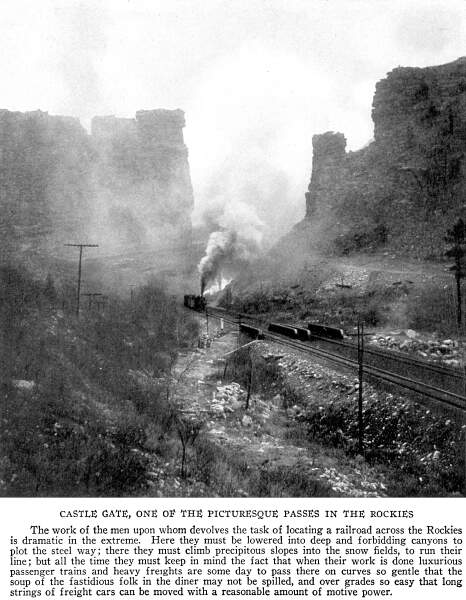 the in formation
to the bulletin-board and other points around the station, advising
the 200 or more porters, baggagemen, and others on what track
and at what minute the train will stop. the in formation
to the bulletin-board and other points around the station, advising
the 200 or more porters, baggagemen, and others on what track
and at what minute the train will stop.
Among loud-speaking telephones, telegraph instruments, and
electric lights, the interlocking station director is a commanding
general who is in constant touch with every sector held by his
forces.
All the switches and signals must be set positively before
the leverman at the "pianobox," as the mechanism is
known, can lock the switches.
At the Grand Central Station trains leave on schedule time.
No wait is made for belated passengers. The gates close and the
train goes, each at a predetermined time. A red light near 45th
Street signals the closing of the gates.
403
Train dispatching at the Pennsylvania Station differs somewhat
from that at the Grand Central. Here the tower spans the tracks
and the tower director sees the trains he guides in and out of
the station.
It is a fascinating experience, though one conducive to high
stepping, to be privileged to go down through the maze of tracks
and third rails to the big tower, where the trains are guided
into and out of the big station.
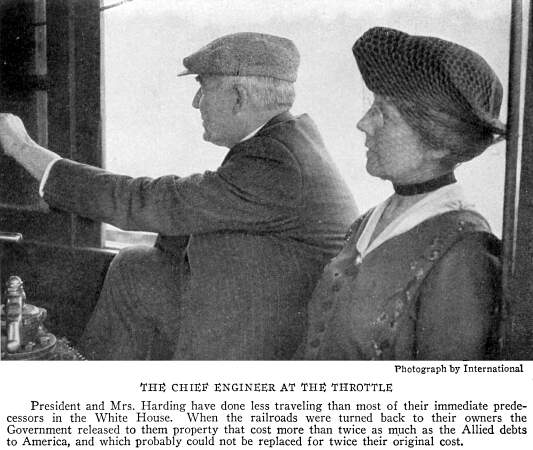 Here one may
see the whole track layout, from the New Jersey portal of the
Hudson tunnels into the station. Instead of a frosted glass diagram,
as at the Grand Central Station, one finds the tracks themselves
in miniature. Every switch is in its appropriate place and every
signal also; and as the leverman throws the switches on the steel
highway itself, the ones on the brass miniature move in harmony.
Every part is built, and every motion is made, to scale. Here one may
see the whole track layout, from the New Jersey portal of the
Hudson tunnels into the station. Instead of a frosted glass diagram,
as at the Grand Central Station, one finds the tracks themselves
in miniature. Every switch is in its appropriate place and every
signal also; and as the leverman throws the switches on the steel
highway itself, the ones on the brass miniature move in harmony.
Every part is built, and every motion is made, to scale.
As one stands in the big tower a signal light goes out as a
big limited leaves the Hackensack Meadows and begins its plunge
under the Hudson. The director of the Jersey tower reports its
passage and the station-tower director gives orders to the levermen,
who set the switches for the track on which the train will roll
into the station.
With watch in hand one observes the course of the train through
the Hudson tube. As it starts into the tube the speed increases,
as is shown by the rapidity with which the miniature signal lights
go out and come on again, for the tubes swing down deep under
the Hudson.
Then, as the lowest point beneath the river is passed and the
train begins to climb the steep grade up to the east bank, it
slows down rapidly. Light after light goes out, stays out until
another ahead of it is darkened, and then shines again, proclaiming
the fact that the block ahead of it is clear.
Presently in rolls the big limited, right under the big tower,
and several hundred people flock out of it, little thinking of
the wonderful mechanism that stands guard over the maze of tracks
and switches and
404
never fails to send each train into its appropriate berth.
With regret one leaves untouched a hundred and one phases of
railroad operation that would add to the picture of the vastness
of the task of moving the nation's freight and carrying its passengers,
as well as of the intricacy of the details of a year's transportation
business. Put the phases that have been considered are representative
as well of those which must be passed by. The economics of railroad
operation are beyond the scope of this article.
RAILROAD DEVELOPMENT IN AMERICA
The history of railroad transportation in the United States
is a story of amazing development. At the outbreak of the Civil
War the country had less than 31,000 miles of line, of which only
about 2,000 were west of the Mississippi. It was not until February
22, 1863, that the first sod was turned in the projection of the
first transcontinental line, on the Pacific end at Sacramento;
and not until December 2 of the same year that work began in the
Mississippi Valley.
Six years later, after many vicissitudes and after 225 miles
of overlapping line had been built, an agreement was reached whereby
the two companies joined forces, and the golden spike which tied
together the East and West was driven at Promontory, Utah (west
of Corinne), on May 10, 1869.
The railroads, indeed, constitute the key that unlocked the
treasure-house of American resources. The story of the nation's
rise to greatness and power is an account of a succession of frontiers.
At the beginning the frontier stopped at the Blue Ridge Mountains.
The turnpike and the canal finally pierced these heights and let
it move on to the Alleghenies. These became an isolating influence
that held the pioneers in the eastern half of the Mississippi
Valley almost a separate people from those on the Atlantic seaboard
until the railroad builders' faith removed these mountains, as
far as the flow of commerce and communication was concerned.
In turn the Mississippi River became the frontier. What was
the good of the land west of the Father of Waters if that stream
remained unbridged?
Even as late as the early eighties our people thought that
it was useless to build railroads through western Minnesota and
the Dakotas, arguing that the region was a desert in summer and
a wilderness of snow in winter; and it took Custer's campaign
against the Indians to persuade the public that the Northern Pacific
extension beyond the Mississippi, at St. Paul, could be kept open
more than five months a year.
During the Civil War the South had much less than a third of
the nation's railways. Furthermore, these linked up distant communities
rather than industrial centers. Comparatively few of them were
strategic, whereas the North had rail connections admirably fitted
both for the movement of men and munitions and for the interchange
of commodities essential to the fabrication of these munitions.
In Europe the history of railway construction has been that
of roads laid down to meet the demands of traffic already there.
In this country tens of thousands of miles of line have been built
through virgin territory, which it was hoped would grow up to
their facilities.
Linking the ore of the Minnesota mines and the coal of the
Pennsylvania mountains, the farms of the Mississippi Valley with
the markets of the Atlantic Slope, the trucking and fruit-growing
districts of Florida and California with the consuming centers
of the East and the North, the geography of railway traffic in
America has been developed along lines that eliminate distance
and make the whole United States one great homogeneous community,
tied together by bands of common interest, as are the people of
no other equal area in the world.
Far-flung as are the boundaries of the United States, it is
now possible to interchange commodities between any two places
within those boundaries with less transportation costs than were
paid between relatively close communities a hundred years ago.
The United States has about one-sixteenth of the earth's land
and an equal proportion of its population, yet it has nearly a
third of the world's railway mileage. Its population is only one-fourth
that of Europe, yet it has almost enough miles of line to duplicate
the systems of Europe and Asia together.
Stories Page | Contents Page
|







